A New, Safer Future for Third Ave in Brooklyn
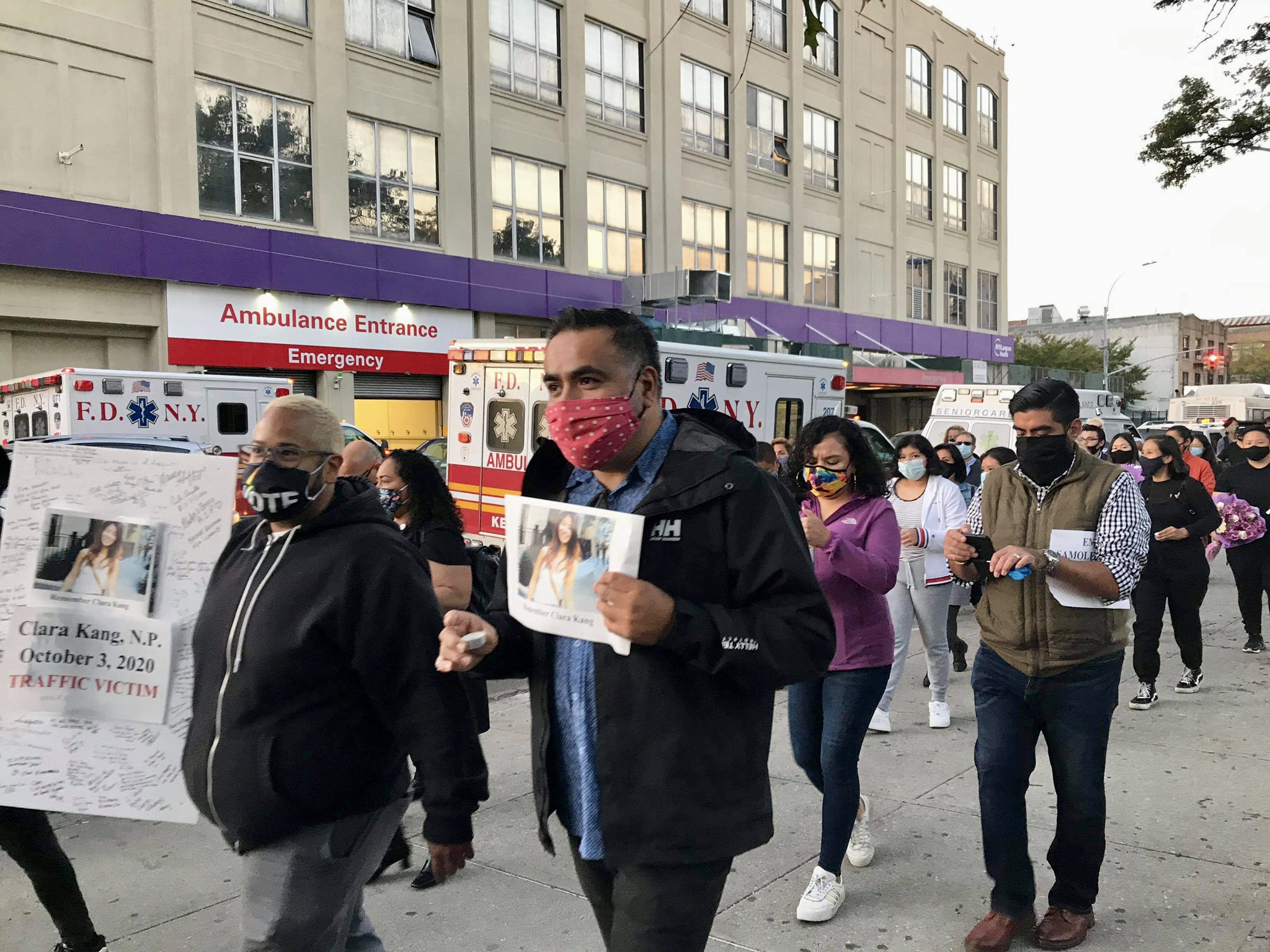
At the 2020 vigil for Clara Kang
Three years ago, my Brooklyn neighbors and I stood in Martin Luther Playground and held a vigil for Clara Kang. She was a nurse at NYU Langone Brooklyn (still called Lutheran Medical Center by locals). While we were at home during covid lockdown, Clara was literally saving lives. She was killed on 56th Street while bicycling home from a shift at the hospital.
Official after official stood in that park and told us not one more death on Third Avenue - but sadly, even after more crashes, accidents, and fatalities, little has moved the needle in fixing the corridor stretching from Prospect Ave to 65th St, leaving community members outraged and calling for change. Over the years, Third Avenue has seen an alarming number of crashes involving pedestrians and cyclists. In the last 10 years alone, there have been over 1,600 reported crashes along Third Avenue and more than 13 fatalities (see NYC Crash Mapper).
No more.
The New York City Department of Transportation (DOT) has finally heard these concerns and has begun a safety study for Third Avenue - beginning with two workshops, which are aimed at hearing about and addressing the safety issues along the corridor. The first was held on April 18 and the second and final workshop will be held on Thursday, April 27 at PS 503/506 (old school Sunset Parkers still call it PS 314). It is crucial that Sunset Park residents attend this workshop to ensure their voices are heard and that DOT understands the community's concerns.
The importance of community participation in this process cannot be overstated. The workshop organized by DOT presents a unique opportunity for the community to come together and work towards a shared solution. The workshop aims to gather input from community members on their experiences with Third Avenue and their ideas for improving safety. This feedback will be used to develop a plan for redesigning Third Avenue to make it safer for everyone who navigates the corridor — students, families, small businesses, and others.
By participating, community members can provide valuable insights into how Third Avenue can be redesigned to be safer for pedestrians, bike-riders, and drivers alike. They can share their experiences of navigating the corridor, highlight problem areas, and suggest potential solutions. In addition, community participation will demonstrate to DOT the level of urgency felt by the residents of Sunset Park. It will show that we are invested in making our community a safer place for everyone, and that we are willing to work collaboratively to achieve this goal.
The final Third Avenue Workshop organized by DOT presents a unique opportunity for the Sunset Park community to come together and work towards a safer corridor. It is imperative that community members attend this workshop and provide input and feedback to ensure that the solutions developed are in line with community needs and concerns. By doing so, we can demonstrate our commitment to making our community a safer place for everyone, and help pave the way for a safer future on Third Avenue.
***
Julio Peña III is Chair of Brooklyn Community Board 7 and has been a member of the board since 2016. The final DOT workshop on Third Avenue is Thursday, April 27 at 6:30pm at PS 503/506, 330 59th Street — learn more about the workshops and provide feedback here. On Twitter @Julio_PenaBK.
***
Have an op-ed idea or submission for Gotham Gazette? Email This email address is being protected from spambots. You need JavaScript enabled to view it.
Little Has Changed Since I was Held on Rikers; It's Time to Shift Resources as We Close the Jail
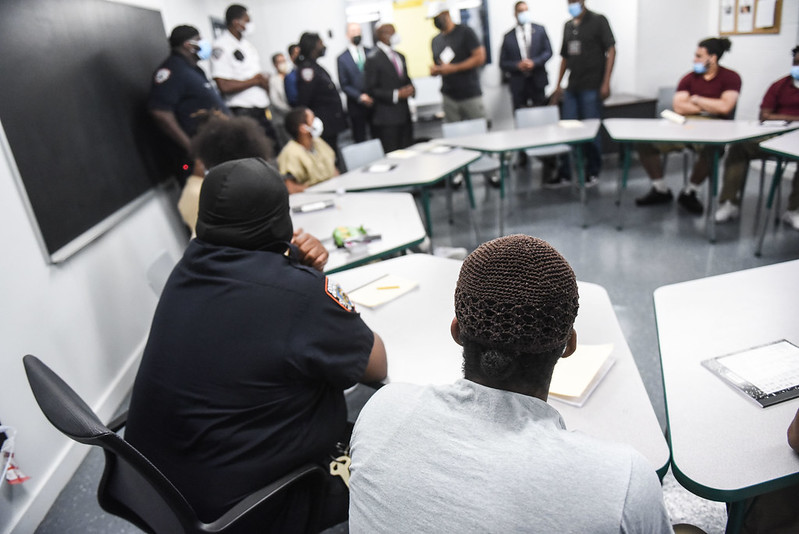
A classroom on Rikers Island (photo: Michael Appleton/Mayoral Photography Office)
I spent three-and-a-half years on Rikers Island, as both an adolescent and adult. During this time, I experienced and witnessed countless episodes of abuse and neglect, including frequent medical and mental health neglect, and the inadequacy of programming that properly prepares those detained for community reentry.
It appears that very little has changed in the 31 years since I was incarcerated, and conditions may have worsened. In the past two years, 36 people have died after being held in the custody of the Department of Correction, including 19 people last year alone.
Instead of relying on this broken system, we should close Rikers Island by 2027, as is the law, and invest in resources that will keep all of us safe: supports for those reentering our communities, such as behavioral health services, substance use treatment, medical care, employment support, and more.
Those held on Rikers are suffering needlessly and in ways that render everyone there – staff and people in custody alike – unsafe. Over half of the people in Correction’s custody have a mental health diagnosis – and between 20% and 50% desperately need consistent mental health treatment of some kind – yet from February to October of 2022, people in custody missed over 12,000 medical appointments, in part because staff were not there to escort them.
This is simply unacceptable and must not be rewarded by increasing the budget for an agency that is failing to provide basic services to those in its custody and control.
The proposed city budget for the Department of Correction represents an increase of more than $35 million, and projects that 88.5% of agency expenses are earmarked for staff salaries and benefits. This is both disproportionate and shocking, because the Department does not lack financial resources.
The problems in our jails will not be solved by increasing funding for the same line items that are not only failing to produce results but resulting in harm and death. In 2022, our city spent 350% more for each incarcerated person than the two other largest jail systems in the country — Los Angeles and Cook County, Illinois — and yet individuals in its custody are being subjected to horrific conditions.
One way that cost savings from the budget could be utilized is to enhance funding for supportive housing for people leaving jail and prison, to prevent them from returning. Current funding for Justice Involved Supportive Housing is so far below what is sufficient that no current service provider, including my organization, The Fortune Society, submitted a proposal to receive that funding.
That was a painful choice to make given the need, because the Fortune Society, which supports successful reentry from incarceration and promotes alternatives to incarceration, has been in the business of providing such housing for more than two decades.
Another solution would be to enhance the Board of Correction: the Board must have the staff necessary to perform its city charter-mandated oversight of the Department of Correction. The Board needs the resources to conduct regular, unscheduled visits to observe jail conditions and speak with people in custody, as well as Correction staff. Having eyes and ears on the ground has proven crucial to the Board’s ability to report on the circumstances surrounding the deaths of people in custody.
At The Fortune Society, we believe in the power of people to change. But the city must change as well in the face of the record number of deaths and persistent dysfunction at Rikers.
The city is bound by law to close Rikers Island by 2027. Given the waste of our taxpayer funds on a broken system, the mayoral administration must adhere to that timeline, while investing in crucial jail oversight, alternatives to incarceration programs, reentry services, and supportive housing.
This is not only a pathway to humane treatment, but also one with a proven track record of improving public safety. We can no longer avoid what has become a stain on the conscience of our city – and continue to put too many lives at stake.
***
Andre Ward is the Associate Vice President of The David Rothenberg Center for Public Policy at The Fortune Society. On Twitter @AAWardSR1 & @thefortunesoc.
***
Have an op-ed idea or submission for Gotham Gazette? Email This email address is being protected from spambots. You need JavaScript enabled to view it.
Clean Slate is Good for New York’s Businesses
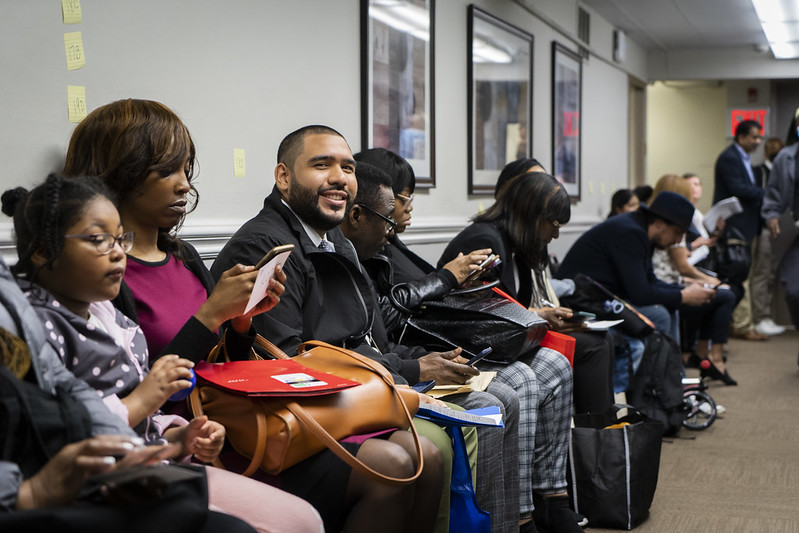
Ready to work (photo: Caroline Willis/Mayoral Photography Office)
Across New York, many employers continue to struggle to find workers.
The labor market remains tight, even amid fears about a looming recession. According to a recently released study by the U.S. Chamber of Commerce, there are over 450,000 open jobs in New York State with only about 400,000 unemployed New Yorkers. This workforce shortage has a devastating impact on the New York economy as it drives up costs, makes it difficult for businesses to expand, and becomes a disincentive for businesses to relocate to New York.
Yet there is a way for our State Legislature to help employers bring workers back into the economy, while also making our communities safer. Indeed, this is exactly what the Clean Slate Act would do (S1553-Myrie/A6399-Cruz).
It's state legislation that will seal old conviction records and enable more than 2.3 million New Yorkers to obtain jobs. This crucial bill will help businesses across New York hire employees, boost our state’s economic growth, and increase public safety.
The Clean Slate Act has growing support across the state, including from Fortune 500 companies, business groups, labor unions, and local and county legislatures.
After old conviction records are sealed, individuals are more likely to obtain jobs, stay employed, support their families, and strengthen their communities. Those are positive outcomes that will benefit every town, city, and county in New York.
According to a recent analysis, the Clean Slate Act would generate an estimated annual earnings boost to New York State of $7.1 billion.
The Clean Slate Act would automatically seal old conviction records for New Yorkers who have successfully completed their sentence, are no longer on community supervision, and have not incurred any new charges or convictions after three years for misdemeanors and seven years for felonies. We have to ask ourselves, what is enough? When people have paid their debt, when can they move forward?
These New Yorkers want to work and contribute to our economy, but are currently held back in doing so because of their old convictions. By decreasing barriers to jobs, housing, and education, the Clean Slate Act will make it easier for these New Yorkers to support themselves and their families.
Research shows that, after old conviction records are sealed, individuals are more likely to maintain employment and increase their earnings, and less likely than members of the general public to be convicted of a crime.
Let’s be clear on what this means: sealing old conviction records helps reduce crime and increase public safety because it enables more job-seekers to enter the workforce and remain employed, rather than re-engage in criminal activity.
New Yorkers of all backgrounds should welcome the Clean Slate Act. There are limits to the sealing provided in the legislation. Records remain accessible for a number of purposes, including work in certain regulated fields, as well as to law enforcement and the courts. In carefully crafting the bill, the Legislature has considered a wide array of interests, including businesses, which has contributed to the support from so many business leaders, like JPMorgan Chase. The result is a strong bill that will benefit directly-impacted people, their families and communities, as well as employers and New York State as a whole.
Clean slate bills are proven to work. Consider a recent study on Michigan’s clean slate law: it found that, within two years of Michigan clearing old conviction records, residents of that state were 11% more likely to have a job and were earning 25% more in income.
Across the country, clean slate bills have earned bipartisan support and passed in red and blue states including Utah, Connecticut, California, and Michigan. Even Texas, Missouri, and West Virginia are actively considering them now as well.
Nationally, excluding individuals with old conviction records from the workforce costs the economy as much as $87 billion annually in lost GDP — a devastating loss for businesses, workers, families, and communities.
Here in New York, clean slate can’t wait. Our message to Governor Hochul and the legislative leaders is: let’s get it done.
***
Paul Zuber is executive vice president of the Business Council of New York State. Catalina Cruz is an assembly member representing Queens’ district 39. On Twitter @NYAssemblyCruz & @BusinessNYS.
***
Have an op-ed idea or submission for Gotham Gazette? Email This email address is being protected from spambots. You need JavaScript enabled to view it.
Want to Cut Emissions in New York City? Pass This Zoning Amendment
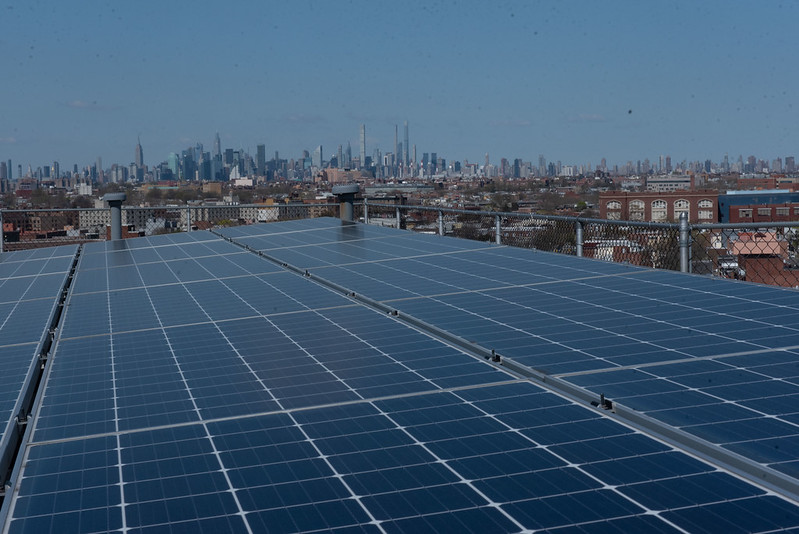
A solar future (photo: Michael Appleton/Mayoral Photography Office)
Climate change is here – and it is here to stay unless we take immediate action. One simple but meaningful way to make an impact is to empower property owners with the tools they need to reduce or altogether eliminate building emissions.
Fortunately, the New York City Department of City Planning’s proposed City of Yes: Carbon Neutrality is up to the task. This zoning reform (a “zoning text amendment” in land use jargon) will help New York meet its goal of cutting 80% of carbon emissions by 2050.
At the New York State Association for Affordable Housing (NYSAFAH), our members want to retrofit their buildings to reduce their carbon footprints, but archaic zoning rules stand in the way – rules created 60 years ago, in an era when asbestos insulation and leaded gasoline seemed like pretty good ideas. City Planning has put forth the right proposal to deal with this challenge, and now we just need the City Council to approve it.
Many affordable housing developments across the five boroughs were built in another era, long before energy efficiency became a priority – and long before modern tools were conceptualized and brought to market. What’s more, many affordable and public housing developments were built in low-lying areas that are particularly vulnerable to climate threats like storm surges and rising sea levels. In fact, we’ve already seen the damaging impacts from Superstorm Sandy, Hurricane Ida, and other extreme weather events that are only growing more common.
Among other benefits, the proposed zoning tweaks would allow elevated solar panels to cover 100% of a roof area, possibly increasing potential solar energy generation by 290%. This is a massive step to improve solar energy progress in New York – a need that will only grow as electrification continues to gain prominence.
City of Yes: Carbon Neutrality would also enable building retrofits for exterior insulating panels, which will help prevent energy waste. Adding insulation inside a building often reduces apartment sizes and leaves gaps in the façade for heat to leak. Due to floor-area regulations for affordable housing properties, developers are often prevented from installing exterior cladding. The zoning change would help remove those arbitrary and outdated restrictions.
Heating and cooling systems across buildings are vital for reducing the city’s overall carbon footprint. Most New York building furnaces and boilers run on natural gas and oil, accounting for about 42% of the city’s total greenhouse emissions. However, current zoning text restricts infrastructure on roofs and yards, often preventing building owners from pursuing electrification. City of Yes: Carbon Neutrality would expand the ability to place HVAC equipment, like heat pumps, in these areas for more efficient energy systems.
In other words, these are minor changes everyone already agrees with that will have a big impact – and they are examples of the sort of proactive climate thinking New York needs.
Every day that the zoning text goes unchanged is another one that we are preventing more responsible, ethical energy practices in New York City. We cannot afford to skirt these changes any longer. We hope that the Community Boards, Borough Boards, Borough Presidents, City Planning Commission, and City Council will vote to approve this zoning text amendment as soon as possible. New Yorkers deserve no less.
***
Jolie Milstein is president and CEO of the New York State Association for Affordable Housing. On Twitter @NYSAFAH.
***
Have an op-ed idea or submission for Gotham Gazette? Email This email address is being protected from spambots. You need JavaScript enabled to view it.
New York Can’t Put the Blindfold Back On: Legislature Must Reject Rollbacks to State Discovery Laws
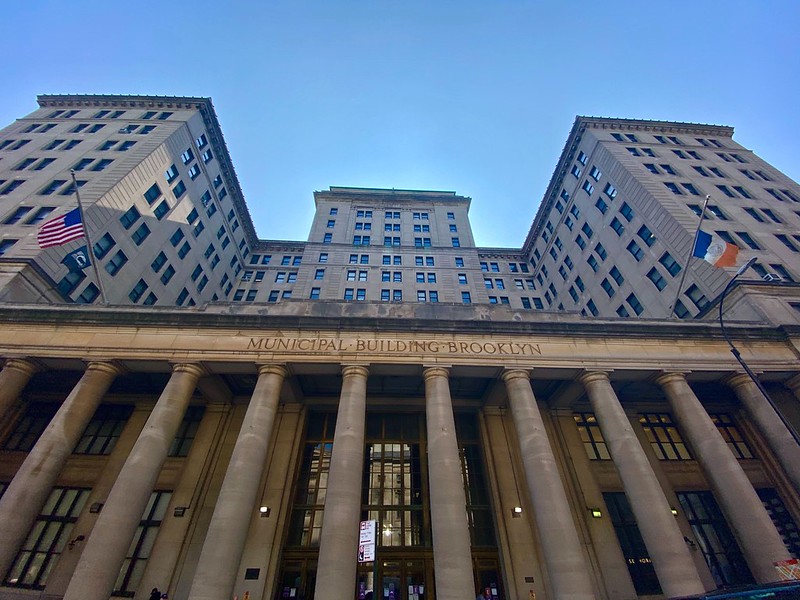
Protecting halls of justice (photo: Michael Appleton/Mayor's Office)
In 2013, a fight broke out among dozens of people near a nightclub in the Bronx where Aaron Cedres worked as a bouncer, and one man was seriously injured. Though he insisted that he had only broken up a separate fight, Cedres was charged with gang assault, a charge that carried up to 25 years in prison if convicted. Prosecutors told Cedres’ public defender that surveillance footage of the fight looked bad and offered him a plea deal for five years in prison. He maintained his innocence and urged his attorney to acquire the footage.
Cedres’s attorney requested the footage from the District Attorney but they delayed and delayed, taking months to turn over security footage that ultimately disproved the allegations against him. Discovery laws — laws pertaining to the disclosure of evidence — were in the prosecutors’ favor; they were not required to turn over the video footage until they were ready for trial. They used the law to their advantage to try to pressure Cedres into taking a plea deal without seeing the evidence against him, or risk going to trial where he faced a greater prison sentence.
After more than a year, his case was dismissed, but the charges had already cost him his job, his car, and his apartment. Cedres won his case, but lost everything else due to New York’s antiquated discovery laws.
In 2019, in an effort to address this and similar injustices, New York overhauled its discovery laws, falling in line with 47 other states that require full and timely discovery. Yet, alongside New York prosecutors, Governor Hochul is now trying to undo this progress in ongoing closed-door budget negotiations. They would revert the state’s evidence-sharing practices back to the same era that upended the life of Aaron Cedres and so many others.
For decades, prosecutors and police were allowed to withhold evidence from people accused of crimes and their attorneys until the eve of trial, effectively “blindfolding” them.
This unjust system denied people access to crucial information, such as police reports and witness statements, keeping them and their attorneys in the dark — unable to investigate, prepare a defense, or make an informed decision about whether to accept a plea offer. Even when discovery contradicted the prosecutor’s allegations, cast doubt on a person’s guilt, or exposed untruthful testimony by police or other witnesses, prosecutors routinely got away with withholding this vital information.
The consequences of the “Blindfold Law” were delayed trials, less effective defense representation, coerced guilty pleas, and one of the highest rates of wrongful convictions in the nation.
In 2019, the State Legislature enacted a fair discovery statute, which required prosecutors to turn over evidence in a timely and meaningful way, avoiding delays and allowing defense attorneys to adequately prepare for trial.
Now, Governor Hochul and some New York District Attorneys are pushing to gut these transformative discovery laws.
Their proposed legislative changes would shift the burden of identifying discoverable evidence to the defense. This is a practical impossibility as only prosecutors are in a position to know what evidence police have collected in an investigation. If enacted, the change would effectively destroy the 2019 legislation, striking a major blow to transparency and the need to hold prosecutors and police accountable.
This last-minute proposal comes as a shock. Governor Hochul did not seek any changes to the discovery law in her initial budget proposal. And in February, the District Attorneys Association testified that prosecutors need more money to implement the law, but did not call for legislative changes.
One thing is clear: prosecutors and defenders acknowledge that for the discovery system to function as intended, more resources are needed for both sides. In 2022, we all met with Governor Hochul’s office to discuss solutions to a growing backlog of cases caused by the pandemic, and we agreed that more funding was needed for staffing and technology to collect, store, share, and review digital evidence.
Police and prosecutors also must agree to a uniform digital transfer system so that DAs aren’t gathering the evidence piece by piece from individual officers, delaying discovery. The refusal or inability to share files between police and prosecutors is no reason to overturn the law.
Despite our agreed-upon solution, prosecutors have suddenly pointed to a supposed increase in dismissals, citing their inability to comply with discovery as the primary cause. This is untrue. The current law has many “safety-valves” when DAs cannot fully comply with the law: DAs simply need to show that they started requesting the information early and that they did so more than once. Worth noting: their data is incomplete because the reasons for dismissals weren’t accurately tracked until the spring of 2022. It is also clear that the lengthy pandemic affected case outcomes, resulting in dismissals as a way to reduce the backlogs.
Fulfilling the promise of a fairer criminal legal system requires firm commitment to the 2019 landmark law — not a retreat from it that will absolve prosecutors of their obligations and have devastating consequences for people awaiting trial. We urge state legislators to resist the governor’s and prosecutors’ attempt to weaken our discovery laws. Justice depends on it.
***
Yung-Mi Lee is President of the New York State Association of Criminal Defense Lawyers. Mark Funk is President of the Chief Defenders Association of New York. On Twitter @NYSACDL & @chiefdefendsNY.
***
Have an op-ed idea or submission for Gotham Gazette? Email This email address is being protected from spambots. You need JavaScript enabled to view it.
Our Newest New Yorkers Want to Work: What They Need from the President and Mayor
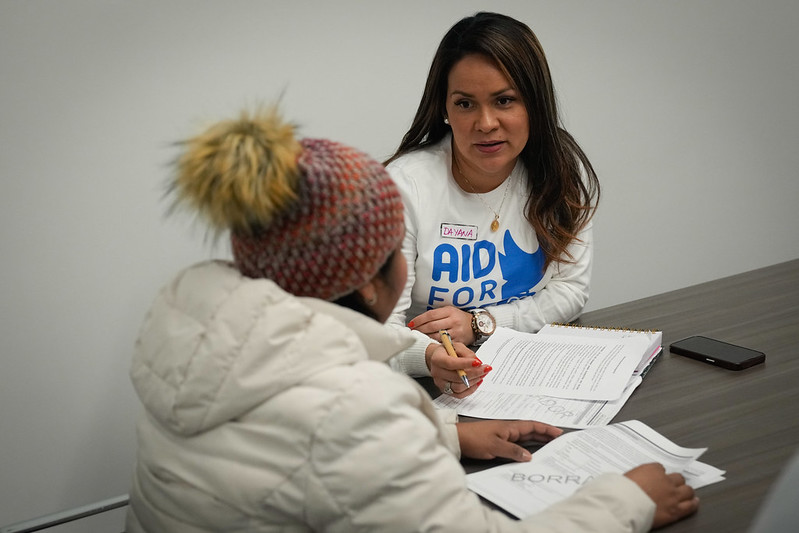
Helping with immigration paperwork (photo: Michael Appleton/Mayoral Photography Office)
Imagine if we could fulfill the American Dream for tens of thousands of vulnerable migrants, save vast amounts of money on temporary housing, and add to the city’s tax base – all at no cost and with no downside. It’s possible: President Biden must give all of New York City’s asylum-seekers employment authorization — today — by granting humanitarian parole to our newest New Yorkers.
New York City is more than $1 billion into a humanitarian disaster not of our making with no end in sight. At least 55,000 migrants from the United States/Mexico border have arrived in the city since April 2023, and more than 34,000 are in the city’s care, according to the administration of Mayor Eric Adams. To meet the need, the City has opened 103 emergency shelters and eight massive humanitarian centers.
Tens of thousands of vulnerable migrants in New York City want and need to work, but very few have been approved to do so. No work means no money. No money means no way to afford an apartment or groceries. No apartment or groceries means full dependence on city social services and non-profit organizations. Full dependence on social services and non-profits means a heavy strain on the city budget and the migrants’ dignity and mobility.
Asylum-seekers are eligible to apply for employment authorization 180 days after their first check-in with an immigration judge. The backlog in immigration court is so severe (there are already more than 110,000 pending asylum cases in New York State) that new appointments for initial check-ins are booked until at least 2025. Some appointments are being scheduled as far out as 2029.
In other words, for tens of thousands of New York City’s recently-arrived migrants, the 180-day clock won’t even start for two to five years.
New York City’s legal service providers estimate just 5% of the 55,000 migrants have completed their first appearance. Those who have are still subject to United States Citizen and Immigration Services backlogs: it takes another 8 to 18 months for employment authorization applications to be approved.
The question is, how do we fix this?
First, the federal government should grant humanitarian parole of at least two years to the migrants who are already in the city. Humanitarian parole provides temporary lawful status in the U.S. while cases are adjudicated and allows migrants to secure work authorization within five to ten months. Humanitarian parole does not take away the requirement to apply for asylum or seek another form of permanent status. It is temporary relief, not a path to citizenship, until additional applications for relief are submitted.
The Biden administration is already using humanitarian parole for 100,000 Ukrainians and 85,000 Afghans. It is a long-established tool to resettle large numbers of people and start their lives while pursuing immigration status in the United States. Temporary Protective Status (TPS) is another route the federal government could take, but the wait time for work authorization is much longer, approximately two years.
Homeland Security has the discretion to grant humanitarian parole without Congressional action. It is adaptable and immediate. The regulations are broad: parole can be granted for “urgent humanitarian reasons” or “significant public benefit.” President Biden should think about what that means in New York City.
Second, the City must increase funding to legal service providers. There are not enough attorneys to get applications moving and maintain continuity of representation for 55,000 migrants (and counting). The New York Immigration Coalition and Catholic Charities Community Services of New York – two of the organizations spearheading legal services for migrants – estimate an additional $30 million is needed for an initial and effective, sustained response on top of the $31.1 million already allocated by Mayor Adams.
Next, the City needs to help with pathways to jobs and financial independence. We commend the mayor for calling on Washington to speed up work authorizations, including through the use of humanitarian parole. In the meantime, the city can do more to prepare people for employment.
There should be English language classes at hotels and shelters, including lessons that are tailored to workplace vocabulary and communication. The City should connect even more migrants with job training and certification programs. There should be financial literacy workshops that help migrants obtain an Individual Taxpayer Identification Number (ITIN), which enables payment of income taxes and helps to establish “good character” in the eyes of immigration court judges. These small investments pay dividends.
Nonprofits are already doing this work. Organizations like the Staten Island-based La Colmena support immigrant workers with a robust list of services such as apprenticeships, resumé writing courses, and legal clinics. Their Occupational Safety and Healthcare Administration (OSHA) and Site Safety Training (SST) courses are in such high demand that there is a 400-person waiting list.
New York City is perhaps the only city in the nation with the infrastructure, jobs, and generosity to handle this crisis, but we can’t sustain it if migrants can’t work. Washington must grant humanitarian parole now.
***
City Council Member Gale Brewer represents parts of Manhattan. Murad Awawdeh is executive director of the New York Immigration Coalition. On Twitter @galeabrewer & @HeyItsMurad.
***
Have an op-ed idea or submission for Gotham Gazette? Email This email address is being protected from spambots. You need JavaScript enabled to view it.
Rowan Wilson Protected the Essential Right to a Speedy Trial
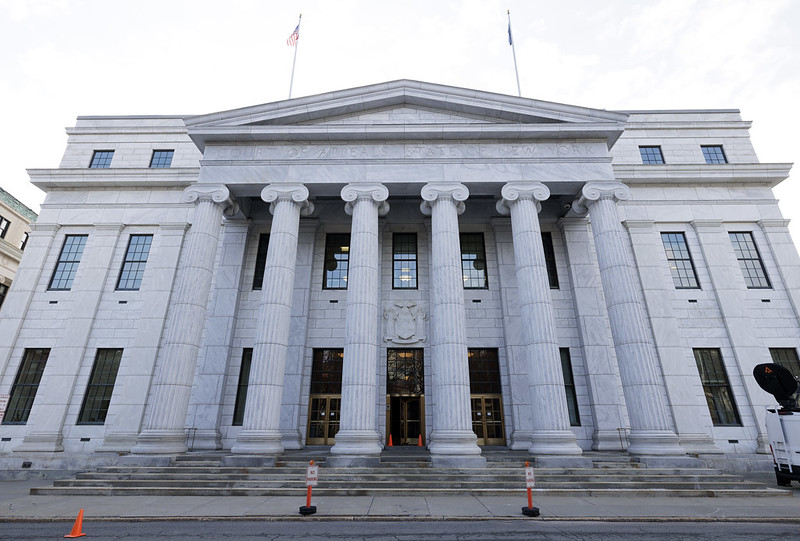
The Court of Appeals (photo: Mike Groll/Governor's Office)
Governor Kathy Hochul’s appointment of Judge Rowan Wilson to be the new Chief Judge of the New York Court of Appeals was widely praised by practitioners, bar associations, and legal academics, who hailed the selection of a brilliant and respected jurist to be New York’s first Black Chief Judge.
But criticism at Wilson’s confirmation hearing centered on a recent majority opinion he wrote in People v. Regan, in which the Court of Appeals overturned a rape conviction on speedy trial grounds. While the facts of this case are tragic, this criticism misunderstands the reasons behind the decision, the importance of the constitutional right at stake, and the effect on future prosecutions.
The Regan case turned on the New York Constitution’s right to a speedy trial, which protects both individual and societal interests. Speedy trials protect defendants from having an accusation hanging over their head for years while they await their day in court. They are also better for victims, for the truth-seeking functions of criminal courts, and for public confidence in the court system. A long-delayed trial is more likely to result in the wrong verdict, less likely to deter criminal behavior, and less likely to satisfy the demands for justice of those harmed.
The right to a speedy trial exists more in theory than in practice, as Kalief Browder’s infamous case illustrates. Browder, a teenager from the Bronx accused of stealing a backpack, spent over three years on Rikers Island awaiting trial, most of it in solitary confinement, before his case was finally dismissed—without a court finding any violation of Browder’s right to a speedy trial. Despite some policy changes, New York’s speedy trial laws still often fail to ensure timely justice, unless there’s proof of egregious negligence by the prosecution.
But egregious negligence is exactly what happened in Regan. After a woman reported she had just been raped by an acquaintance, whom she identified, police administered a rape kit and interviewed the acquaintance, who denied the allegation. Prosecutors then took over three years to obtain a warrant to get DNA from the accused and another year to indict him. For most of that time, by their own admission, prosecutors were doing nothing on this case: not investigating, not interviewing, not even thinking about it. If you’ve ever reported a crime to police and then sat around waiting while it felt like nothing was happening, that’s exactly what happened here—not just for weeks or months, but for years.
New York courts apply a five-factor test to decide when the constitutional speedy trial right has been violated. Applying this test in Regan, four of the six Court of Appeals judges found that the yearslong delay—which the prosecutor’s office could not offer any explanation for—violated the state constitution, so the case must be dismissed. Notably, the majority joining Wilson’s opinion included the Court’s most moderate judge and one member of the three-judge conservative bloc, Judge Anthony Cannataro. Even the District Attorney who lost the case signaled his acceptance of the decision, telling the New York Times, “The facts are so specific and inarguable that I don’t know that you’re going to run into a situation like this down the line.”
Nevertheless, misconceptions about the decision have abounded in recent days. An op-ed in the Daily News described the decision as a break with precedent “requir[ing] courts to give weight to whether the defendant had been prejudiced by delay.” In fact, the Court gave weight to that factor but found it outweighed by other factors, particularly the years in which the prosecution did nothing and the lack of any explanation for this inaction.
The op-ed also complains that the Court could tackle the problem of inexcusable delays by police and prosecutors in other ways, like task forces or “reform initiatives.” But this was a court presented with a case to decide; it was not an option to say “The Constitution was violated here, but we can just overlook that and set up a task force instead.” As Wilson wrote, “Although the constitutional guarantee of a prompt prosecution is not the sharpest instrument by which to address the chronic lackadaisical approach to reports of sexual assaults, affirming the prosecutorial conduct here would establish a precedent—which would apply in every future rape and sexual assault case—that the [prosecution] can delay investigation of a serious crime for years without any explanation or excuse."
The Regan decision should make it easier, not harder, for victims of sexual assault to see their attackers swiftly tried and convicted. Contrary to Republican Senator Steven Rhoads’ claim during Wilson’s floor vote, if someone walks into a police precinct today to report a rape, it doesn’t matter if it occurred last night or 50 years ago: law enforcement can investigate and bring charges. What Regan means is that they actually must do that, and promptly, rather than stick the report in a drawer and forget about it for years. By declining to condone prosecutorial negligence, Wilson’s opinion made clear that swift justice isn’t just a nice idea but a constitutional requirement. Victims, the accused, and every one of us deserves no less.
***
Sam Feldman is an appellate public defender in New York City. On Twitter @srfeld.
***
Have an op-ed idea or submission for Gotham Gazette? Email This email address is being protected from spambots. You need JavaScript enabled to view it.
Does Voting by Mail in New York Really Require a Constitutional Amendment?
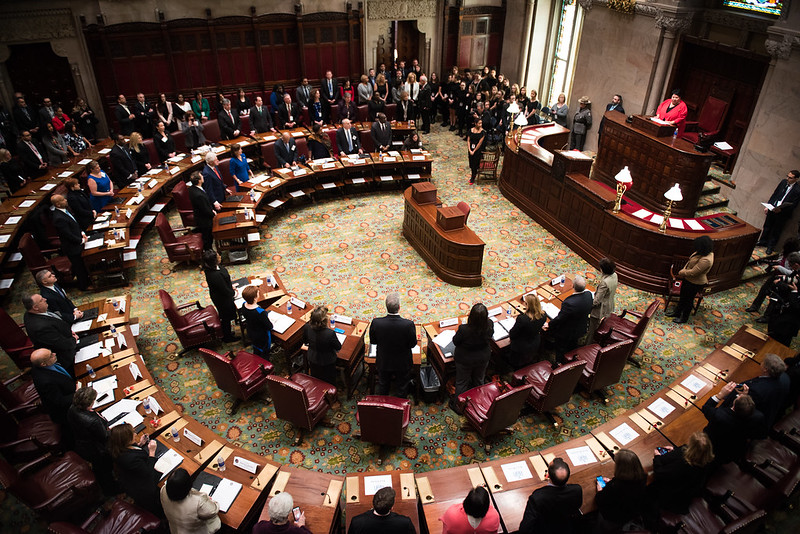
In the State Senate (photo: Edwin J. Torres/Mayoral Photo Office)
Does voting by mail in New York really require a constitutional amendment? Our new analysis says it may not. First, our perspectives on this important issue:
Deborah: I love voting by mail. I can see the ballot in advance, research the candidates and propositions, then cast my ballot without even leaving home; I can check whether my ballot was accepted on the Board of Elections website. Currently, 35 states allow anyone to vote by mail.
But in New York, the only way to vote by mail is to qualify for and request absentee ballots each year. Why?
Jim: Throughout my 32 years in the New York Legislature, we believed that enacting no-excuse-needed mail-in voting required amending the New York State Constitution. This is not easy: two successive classes of both houses of the Legislature have to pass the proposal each term just to put it on the ballot, where voters approve or disapprove it. Nevertheless, I introduced a bill for the amendment and it passed in one house before I retired; it finally appeared on the ballot in 2021 as Proposition 4. The measure failed, but commentators observed that not only was it an off-year election, but supporters didn’t do much at all to counter a well-organized opposition. So the vote was not conclusive, but left us back where we started.
Since the amendment process is so long and unpredictable, we wondered whether an amendment is actually needed. After studying court decisions from other states, we’ve concluded that mail-in voting is in fact compatible with the New York Constitution.
We summarize our analysis below, in the hope that New York state legislators, justices, and others will look at our Constitution with fresh eyes.
***
The key parts of the state constitution are Article II, Sections 2 and 7:
Article II, Section 2: Absentee voting
The legislature may, by general law, provide a manner in which, and the time and place at which, qualified voters who, on the occurrence of any election, may be absent from the county of their residence or,...may be unable to appear personally at the polling place because of illness or physical disability, may vote and for the return and canvass of their votes.
Article II, Section 7: Manner of voting; identification of voters
All elections by the citizens, except for such town officers as may by law be directed to be otherwise chosen, shall be by ballot, or by such other method as may be prescribed by law, provided that secrecy in voting be preserved…
***
Section 7 seems to give the Legislature the power to enact any reasonable method of voting, as long as one’s vote stays private. But New York legislators believe that Section 2 restricts allowable voting methods: that “absentee voting” means any voting that is not done in-person, and, crucially, that any voter not mentioned in Article 2 is forbidden from absentee voting.
There are three other nearby states with similar constitutional language that have enacted mail-in voting laws without a constitutional amendment: Massachusetts, Pennsylvania, and Delaware. The laws were upheld by the supreme courts in Massachusetts and Pennsylvania, and although the Delaware law was ultimately rejected by its supreme court, the judge writing the lower-court decision encouraged the supreme court to uphold the mail-in voting law. (The text of most of these decisions is available via links at the Brennan Center for Justice.)
In essence, New York legislators are using the logic of the maxim “expressio unius est exclusio alterius” (“the expression of one thing is the exclusion of the other”); in other words, the existence of a clause granting rights to some implies that all others do not have those rights.
Is this logic justified? Article 2 does not mention any absentee voting methods, nor does it say that only the listed voters may use this type of voting, yet that is the conclusion from expressio unius.
In Massachusetts, Article 45 (in the Amendments section of its constitution), is analogous to New York’s Section 2 on absentee voting. The Massachusetts Supreme Court explicitly rejected this logic when upholding the state’s mail-in voting law (VOTES Act, June 2022 - see “Lyons” August 2022, p. 27-28).
Moreover, the court warned that “Cases from other jurisdictions have consistently counselled that the maxim [expressio unius] should be applied with even greater caution when interpreting a State constitution, especially where its application would act as a restraint on the plenary power of the Legislature.” (p. 28)
Pennsylvania’s constitution has language similar to New York’s: a clause giving the legislature the power to enact voting methods, and a clause to provide for absentee voting: Article VII, Section 4: Method of elections; secrecy in voting; and Section 14: Absentee voting.
As in Massachusetts, the Pennsylvania Supreme Court reversed a lower-court decision, and ruled that its mail-in voting law (PA “Act 77”, 2019) was constitutional (see “McLinko” August, 2022).
At the heart of the Pennsylvania decision is the court’s belief that, “To be a restraint on the General Assembly’s law-making authority, it must be explicitly set forth or necessarily implied in the Constitution. There is no restriction – other than the maintenance of secrecy – in Section 4 on the methods of election the General Assembly may establish.” (p. 69)
The Pennsylvania court, as in Massachusetts, rejected the interpretation of the absentee-voting clause (Article VII, Section 14) as a ban on mail-in voting for all voters not listed, instead holding that its function is to protect the designated voters: “Whether or not Act 77’s universal mail-in provisions survive future legislatures, [Section 14] guarantees the constitutionally designated qualified voters a way to exercise their franchise regardless of their location on Election Day.” (p. 75)
Lastly, Delaware, which has similar constitutional language (Article V, Section 1: Time and manner of holding general election, and Section 4A: General laws for absentee voting),
also enacted a Vote-by-Mail Statute without a constitutional amendment (Senate Bill 320, 2022). However, its Supreme Court upheld a lower Chancery-Court ruling against the statute (see “Higgin”, December, 2022).
The Delaware Supreme Court acknowledged that the lower court had encouraged it to overturn the ruling (p. 5) and the grounds for the decision can be boiled down to one word, tradition: ”In diverging from the approach taken in Pennsylvania and Massachusetts, we do not insinuate a failure of wisdom or analysis on the part of our learned counterparts in those states; indeed, had our historical record and constitutional tradition not pointed us firmly in the direction we have taken, we might very well have followed their lead.“ (p. 61)
The written decisions from Massachusetts, Pennsylvania, and even Delaware provide good logical arguments why mail-in voting should be constitutional in New York. The key question is whether tradition should prevail over logic. Currently, tradition is winning. But now that we have the infrastructure for widespread, secure voting by mail, is that a good enough reason to delay giving voters this valuable option?
***
Jim Brennan served in the New York State Assembly, 1985-2016, representing parts of Brooklyn and writes a blog on policy and politics. Deborah Franzblau was a mathematics professor at CUNY/College of Staten Island, 1996-2021, and lives in Rockland County. On Twitter @JimBrennanNY.
***
Have an op-ed idea or submission for Gotham Gazette? Email This email address is being protected from spambots. You need JavaScript enabled to view it.
The Theology of Mayor Eric Adams
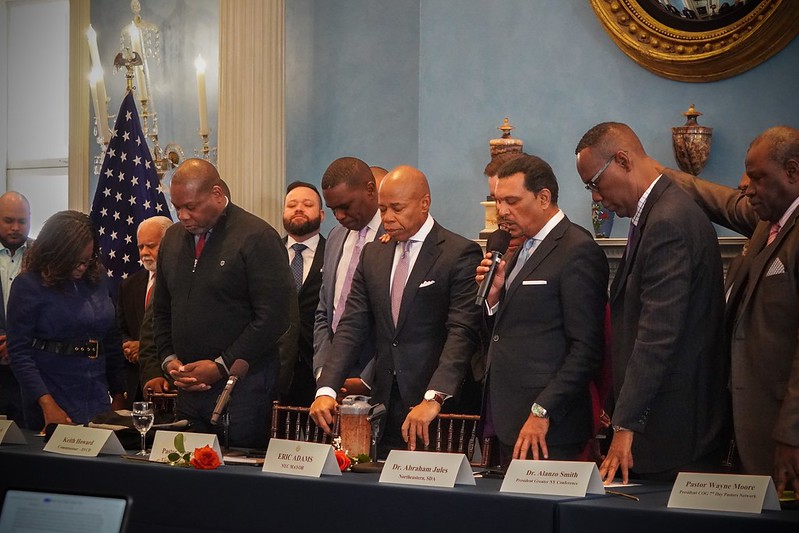
Mayor Adams hosts faith leaders (photo: Benny Polatseck/Mayoral Photography Office)
Mayor Eric Adams recently made headlines for suggesting in a speech that the City of New York would benefit from there being no separation between church and state. On CNN’s State of the Union some days later, Adams clarified his remarks, stating that “Government should not interfere with religion, and religion should not interfere with government.” Though this walk-back did not quell the controversy, it did highlight the precariousness of navigating religion in public life.
Some background on Adams’ beliefs and the broader issue of religion and politics gives context to the mayor’s comments. Most people in my corner of the political world know me for my work as a political consultant and more recently as a political analyst. Many do not know that I am also an ordained minister and that for 16 years I pastored several congregations. My graduate training was in the field of theology; I studied at New York’s Union Theological Seminary under Dr. James Cone, the founder of the Black theology of liberation movement in the United States.
Here, I put on my theologian’s hat and examine Mayor Adams’ recent postulations and their significance for the broader scope of religion and politics.
To begin to understand the mayor’s recent remarks it helps to know his religious background. The mayor was raised in a Church of God in Christ (COGIC) congregation. COGIC is a Pentecostal denomination, and a predominantly Black denomination. In fact, it is the largest Pentecostal movement in the United States. The importance of the Black church tradition on his public service has been previously acknowledged by Mayor Adams. In a late 2021 campaign interview with Gotham Gazette, Adams declared, “I would not be who I am if it wasn’t for the Black church, as a police officer and now as the future mayor of the city.”
COGIC’s reach within the Black community is extensive. The Rev. Al Sharpton was ordained in COGIC, under the leadership of Bishop F.D. Washington, an extraordinary preacher and ecclesial leader. COGIC also counts among its most widely familiar members Denzel Washington (whose family has roots at the Allen Memorial Church of God in Christ congregation in Mount Vernon, NY), Stevie Wonder, and Chris Tucker.
As a Pentecostal denomination, COGIC embraces a theology that is fairly common within such a Christian tradition. It centers the Bible as the Word of God, and embraces many biblical narratives as literal facts, void of any mythic import. It focuses on personal piety; and the belief that God’s Spirit is not a reality aloof from human affairs but is in fact often and consistently at work in individual lives and capable of transforming broader society. This same Spirit is active in the empowerment and uplifting of the most vulnerable.
The significant communal involvement of many Pentecostal and Evangelical churches in underserved communities around our city and state is therefore not surprising. Many of the organizations that have worked on housing, drug rehabilitation, and food insecurity issues, for instance, and that have done so with little or no government funding, have been church-led. To understand Mayor Adams’ belief that his election is part of God’s purpose for New York is to be aware of this commitment and involvement.
Pentecostals firmly believe in the ever-present reality of God in our historical circumstances. Their fervor for spreading the Gospel (evangelism) is undeniable, including the idea that evangelistic efforts should lead not only to the salvation of souls but also to the transformation of society. Hence, within the Pentecostal tradition it is not uncommon to hear comments like those of Mayor Adams about the necessity of re-instituting certain practices of yesteryear, like prayer in schools.
Inviting God’s Spirit into the mundane, Pentecostals believe, will lead to the needed transformation of society. For Pentecostals, much of the content of Mayor Adams’ remarks is familiar. Most of them would support his declarations, though some might perhaps take umbrage at the initial remark on the problematic nature of separation of church and state, that Adams subsequently walked back.
The extent of Mayor Adams’ dependence on Pentecostal thought and practice may end at the idea of God’s continual involvement, and our invitation of God’s involvement in our affairs. For Adams departs from broader Pentecostal practices when it comes to some of his apparent religious practices. For instance, Adams’ collection of Buddhist statues and his belief that “’a special energy’ comes from New York since it sits on a store of rare gems and stones” would certainly be considered weird if not heretical by most, if not all, Pentecostals.
In any event, it is clear that the influence of Adams’ COGIC background continues to permeate much of his worldview.
Adams, considered a moderate-to-conservative Democrat, is not the only elected Democratic official whose political stances are influenced by certain Christian sensibilities. While in New York we can think of a number of former and current elected officials who fit this bill, we can also point to a more national figure who has earned the praise of progressives and moderate Democrats alike.
Senator Reverend Raphael Warnock was raised in the Holiness Church tradition. For him, too, the utterances of Mayor Adams are familiar. Warnock’s parents were both pastors and he is also a pastor, serving since 2005 as senior pastor of Ebenezer Baptist Church in Atlanta. Like me, he is a graduate of Union Theological Seminary and a former student of Dr. Cone, referenced above.
To understand the influence and impact of Warnock’s religious sensibilities, one need only revisit his victory speech last November. Warnock’s speech was filled with vivid religious language. On a national platform, he unapologetically drew on the language of faith that nourished him and that continues to propel his work. After thanking Georgians, Warnock proclaimed the words that countless Christians have uttered through song and sermons — “to God be the glory!”
“I have often said that a vote is a kind of prayer for the world we desire for ourselves and for our children. It is faith put in action. It is the sober recognition that we pray not only with our lips but with our legs,” the Senator proclaimed, employing the cadences of the preacher that he is.
Again not shying away from articulating his faith, in another instance Warnock described democracy as the fulfillment of a greater spiritual reality: “I believe that democracy is the political enactment of a spiritual idea. The notion that each of us has within us a spark of the divine…We all have value. And if we have value, we ought to have a voice.” Accentuating this idea, Reverend Warnock declared what guides his own political philosophy—the idea that “each of us has within us a spark of the divine, that we were created in imago Dei, in the image of God."
Despite some Christian trajectories that are similar to Adams’, the theological and political stances of Warnock are in fact quite distinct. As a Baptist minister, Warnock fiercely defends the principle of the separation of church and state, a stance that Baptists consider a key Baptist “distinctive,” the idea of which goes back to their origins in England and Holland and were brought over to the beginnings of the U.S. through leaders like Roger Williams.
Furthermore, some of Warnock’s progressive stances are in fact driven by a particular theological posture, one indebted to the liberation theology movement. At the heart of this movement is the idea that the plight of the most vulnerable is one that deserves our priority response.
While clearly there are differences between Adams’ and Warnock’s worldviews, one cannot deny that faith has and continues to play a pivotal role in their own political philosophies and work, including as elected officials. And they are not shy about expressing this very fact.
***
Eli Valentin is a political analyst and author of the forthcoming book, Reinhold Niebuhr: A Political Life. On Twitter @EliValentinNY.
***
Have an op-ed idea or submission for Gotham Gazette? Email This email address is being protected from spambots. You need JavaScript enabled to view it.
New York City Needs Federal Legislation for Preventative Climate Resilience
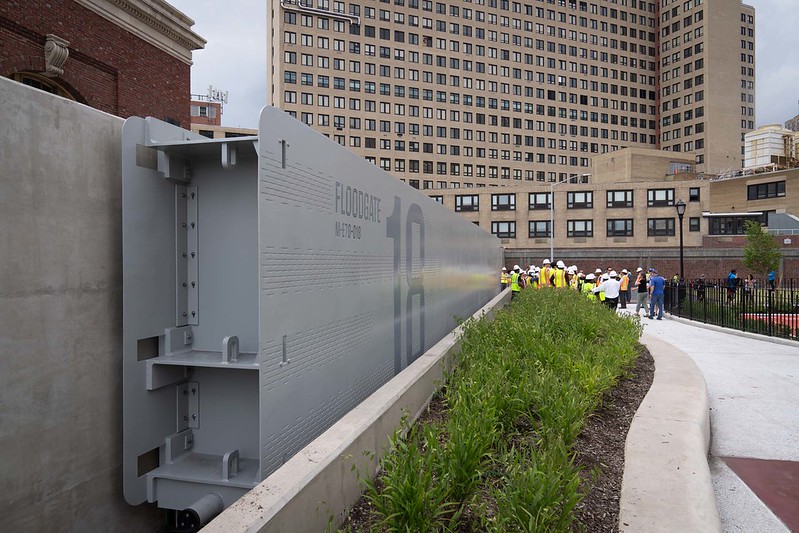
Climate resiliency efforts (photo: Ed Reed/Mayoral Photography Office)
Our nation faces a growing and urgent need to enhance our resilience to flooding and other natural disasters, which are becoming increasingly frequent, intense, and costly. For example, since 2000, flood-related disasters in the U.S. have accounted for more than $850 billion in damage and losses. We can no longer afford to delay action to more fully and proactively address the devastating effects of extreme weather events such as these.
New York City is addressing this on a municipal level – earlier this year Mayor Adams announced the expansion of stormwater management projects in flood-prone communities, which is a step in the right direction of looking to update our existing infrastructure to mitigate the impact of flooding events.
However, it's crucial that all levels of government take action to improve our resilience to these challenges – and we particularly need support on a federal level. As it stands now, the federal government's siloed approach to resilience often creates inefficiencies and challenges for state and local partners. The current approach contributes to wasted taxpayer dollars and missed opportunities to address risk.
What we need is a piece of federal legislation that can streamline federal resilience operations and help fill the nation's resilience gaps – bolstering the efforts that city and state governments are leading. Key components of any bill of this kind should include:
Creating a Chief Resilience Officer (CRO) position within the White House to improve the coordination of federal resilience initiatives.
This position would align resilience efforts across agencies and integrate them with state and local partners. By creating this role, the federal government can embrace a model being adopted by a growing number of states across the country.
Taking stock of federal barriers to building climate resilience and identifying solutions to address them.
This would involve developing a national resilience strategy that streamlines federal support, leads with science, puts nature to work, and addresses historical inequities. Federal working groups will ensure that the national strategy includes practical and coordinated resilience goals. The strategy will also include incentives to spur local and state adaptation action and prioritize the use of nature-based solutions.
Promoting equity and efficiency.
Leaders within the federal government's resilience operations, such as the proposed CRO, must regularly report on federal resilience efforts, funding resources available for resilience and barriers to improving resilience, and identify ways to ensure that federal funds are being distributed effectively and equitably. This will help address long-standing concerns of local communities and states that federal programs and assistance to address disaster risks are often disjointed, redundant, and overly complicated.
And finally, giving a diverse set of stakeholders a seat at the table in developing the national resilience strategy.
A successful national resilience strategy would account for the values, needs, and expertise of state, local, Tribal, and territorial governments, NGOs, as well as the private sector. This will ensure that actions are equitable and better address the on-the-ground needs of those most vulnerable to climate impacts.
We need the federal government to take this critical step toward improving our nation’s resilience to the growing threats of flooding and other disasters. Solutions like this deserve bipartisan support. It is economically and environmentally sustainable to do so.
We cannot afford to delay action and risk further losses of lives, homes, businesses, and infrastructure. Through these avenues, we can better safeguard the nation – and New York City – from the devastating effects of flooding and other extreme weather events.
***
Dina Rabiner is VP of Economic Development and Strategic Partnerships at the Brooklyn Chamber of Commerce. On Twitter @brooklynchamber.
***
Have an op-ed idea or submission for Gotham Gazette? Email This email address is being protected from spambots. You need JavaScript enabled to view it.
Our Communities Need Fair Pay for Home Care Work; Albany Leaders Must Hear Them
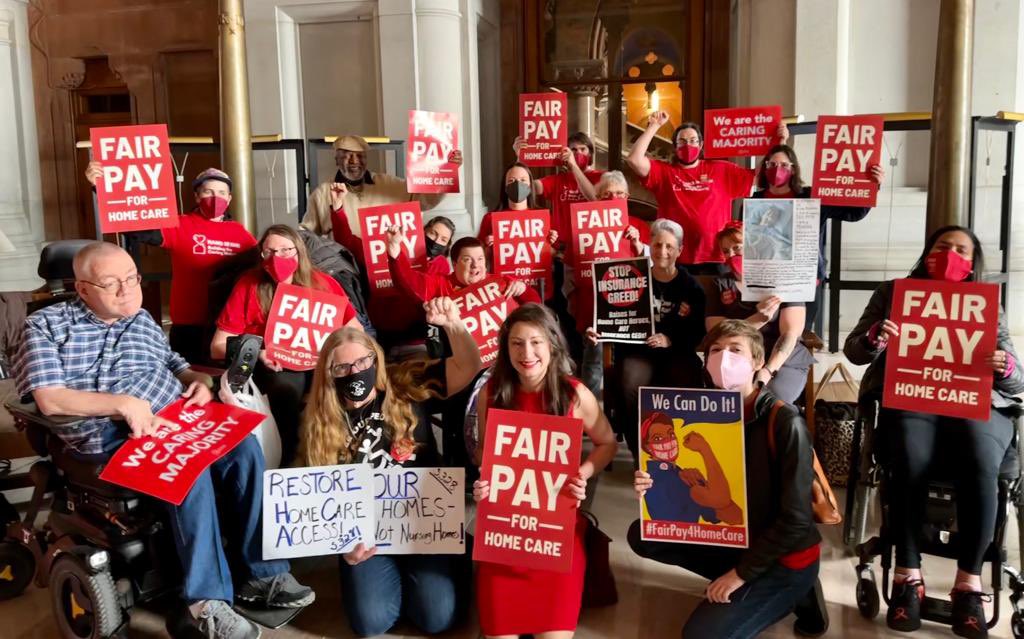
The push for Fair Pay for Home Care (photo: @CaringMajority)
For the first time in United States history, a president has declared April as Care Workers Recognition Month. Making the announcement, President Biden stated, “Care workers help raise our children, assist seniors as they age with dignity, and support people with disabilities." Despite this, care workers remain among our nation’s least recognized heroes.
Today, home care workers are some of the lowest-paid workers in the country and routinely face harsh working conditions. Countless providers are forced to hold multiple jobs and overwhelmingly rely on public assistance programs. One in four home care workers lives under the federal poverty line. In an industry comprised primarily of women, particularly women of color, the impact of this chronic underpayment widens gender and racial pay gaps, and tangibly undermines the wellbeing of our communities.
As President Biden noted, “care is the work that makes all other work possible,” and providing fair pay to home care workers extends far beyond the bounds of labor and economic justice. The vast majority of older adults and people with disabilities in New York would like to remain at home. Therefore, the opportunity to receive skilled health care safely at home and with dignity is a foundational older adult and disability justice issue.
Presently, however, New York faces the nation’s largest home care worker shortage in the nation. Investing in Fair Pay for Home Care in the state’s next budget will put an end to this crisis, incentivizing new workers to join the home care sector.
A 2021 CUNY study found that higher wages for home care workers and improved working conditions would not only attract more than 50,000 full-time home care workers, but the economic multiplier effects would generate tens of thousands of employment opportunities outside of the home care industry. An investment in home care workers would also net the state billions of dollars in savings. But time is short as the state budget process gets down to the wire.
As it stands, Governor Hochul’s executive budget is out of tune with the progress we made last year to index home care wages at $3 per hour above minimum wage. This was a small, but meaningful first step. The next state budget, due any day now, must continue building on this progress, advancing us down a path of justice and equity.
This is a time to recognize that Fair Pay for Home Care is a kitchen table need for millions of New Yorkers. The deliberate policy choice to underpay care workers leaves millions of families struggling to care for aging parents or a loved one with disabilities. But the Governor could work with the Legislature to enshrine Fair Pay for Home Care in the state budget and establish her legacy as a national leader in building a care economy that would make tangible inroads on centuries worth of systemic inequities.
Recent data from AARP-New York shows that 2.2 million family caregivers, predominantly daughters and daughters-in-law, provide 2.1 billion hours of free care, costing the state $39 billion. It’s well acknowledged that the best long-term care insurance you can have is having a daughter or daughter-in-law. We have both served as family caregivers for loved ones and know firsthand that this policy has the dual effect of pushing thousands of women out of the workforce or forcing them to remain in unwanted, unfulfilling jobs, undermining their financial security. Physical and mental health problems also frequently arise as family caregivers often feel isolated meeting the constant demands of caregiving. But we can – and should – do more.
Governor Hochul is New York’s first mother, grandmother, daughter, and granddaughter to serve as the state’s executive, and while her words of support are encouraging, they ring empty without action to pass Fair Pay for Home Care. Today, aging in place is a privilege afforded to few. Fair Pay for Home Care would change this, ensuring New Yorkers in search of care can find it; and will serve as another tangible step toward a future defined by care and love, justice and equity.
***
New York City Council Member Crystal Hudson represents the 35th District in Brooklyn and serves as the Chair of the Council’s Committee on Aging. Bobbie Sackman, MSW, is the former Director of Public Policy at LiveOn NY and is a campaign Leader with the NY Caring Majority and Jews for Racial and Economic Justice. On Twitter @cmcrystalhudson & @SackmanBobbie.
***
Have an op-ed idea or submission for Gotham Gazette? Email This email address is being protected from spambots. You need JavaScript enabled to view it.




